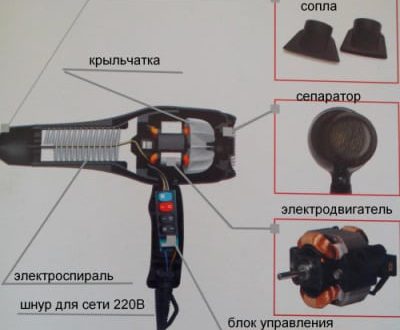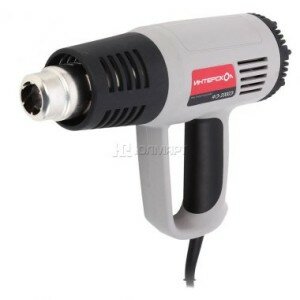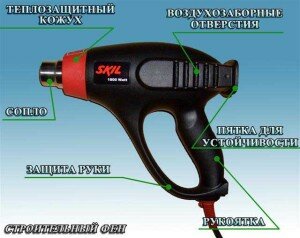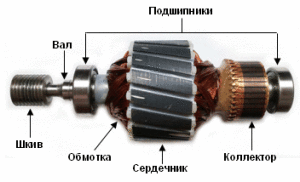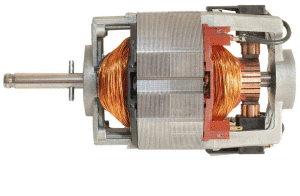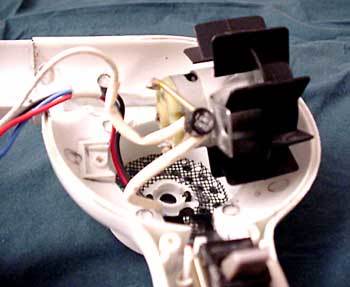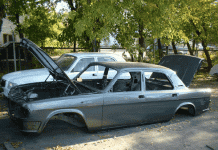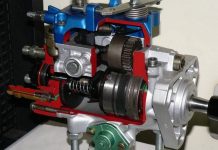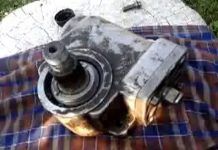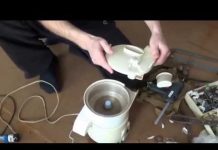In detail: do-it-yourself hair dryer repair from a real master for the site my.housecope.com.
We all are familiar with such an auxiliary tool in construction as a construction electric hair dryer, which we are used to using for removing paint and varnish coatings.
The basic principle of operation of a construction hair dryer is not much different from an ordinary hair dryer that we use to dry our hair.
Accordingly, the electrical circuit of a building hair dryer is similar to the electrical circuit of an ordinary hair dryer.
An explanation will be given in the stated topic:
- electrical diagram of a building hair dryer;
- the principle of the construction hair dryer;
- possible reasons for the malfunction;
- elimination of these malfunctions.
Consider the electrical circuit in Fig. 1 of the building hair dryer:
One diagonal of the diode bridge is connected to an external source of alternating voltage 220V.
The other diagonal of the diode bridge is connected to the electric motor.
The electrical diagram consists of the following elements:
- toggle switch performing the control temperature mode - K1;
- a toggle switch that controls the speed of the blowing speed of the electric motor rotor - K2;
- toggle switch for disconnecting heating elements - K3;
- fan motor - M;
- capacitor - C;
- Heating elements - RTEN;
- diodes - VD1, VD2.
Through the diode bridge circuit of one diagonal of the bridge, the rectified current of two potentials +, - is supplied to the electric motor. When passing from the anode to the cathode, the current flows with a positive half-cycle of the sinusoidal voltage.
Two capacitors connected in parallel in an electric circuit serve as additional smoothing filters.
The blowing speed occurs due to the variability of the resistance in the electrical circuit, that is, when the speed toggle switch is switched to the highest resistance value, the rotation speed of the electric motor rotor decreases due to the voltage drop.
| Video (click to play). |
The number of heating elements of heaters in this scheme is four. The temperature regime of the construction hair dryer is carried out by the temperature control toggle switch.
The heating elements in the electric circuit have different resistance, - accordingly, the heating temperature when switching from one section of the electrical circuit to another - heating the heating elements will correspond to its resistance value.
The general appearance of the construction hair dryer with its names of individual parts is shown in Fig. 2
The following electrical diagram of the building hair dryer in Fig. 3, is comparable to the electrical circuit in Fig. 1
There is no diode bridge in this wiring diagram. Blowing speed control and temperature control - occurs when switching from one section of the electrical circuit to another, namely:
- when switching to a section of an electrical circuit - consisting of a diode;
- when switching to a section of an electrical circuit that does not have a diode.
When a current flows in the anode-cathode junction of the VD1 diode, which has its own resistance, the heating element2 will heat up according to two resistance values:
- resistance at the transition anode - cathode diode VD1;
- resistance of heating element heating element 2.
When a current flows in the anode-cathode junction of the diode VD2, the voltage supplied to the electric motor and the heating element1 will take the lowest value.
Accordingly, the speed of rotation of the rotor of the electric motor and the heating temperature of the heating element for a given section of the electric circuit will correspond to the direct transition of the current of the diode VD2. Heating of the heating element heating element1 for a given section also depends on its internal resistance, that is, the resistance of the heating element is taken into account.
The main reasons for the malfunction of the construction hair dryer here can be called the malfunction of the electronic elements:
Most often, such a malfunction occurs with a sharp jump in an external source of alternating voltage. For example, the cause of a capacitor malfunction is caused by the fact that the capacitor plates are short-circuited when there is a voltage jump among themselves.
Of course, such a possibility of a malfunction as a rupture in the stator winding of an electric motor, winding burnout, is not excluded.
Minor malfunctions include such reasons as:
- oxidation of the temperature control toggle switch contacts;
- oxidation of the contacts of the toggle switch for controlling the blowing speed;
- oxidation of the contacts of the toggle switch for disconnecting the heating elements;
- a wire break in a network cable;
- defective plug lack of contact.
Diagnostics to identify the cause of the malfunction is carried out by the "Multimeter" device.
When replacing a capacitor, its capacity and voltage rating are taken into account.
When replacing a diode, the resistance of two values is taken into account, in the directions:
- from anode to cathode;
- from the cathode to the anode.
As we know, the value of resistance from anode to cathode will be significantly less than from cathode to anode.
With an electric motor, if it malfunctions, things are more complicated. With such a malfunction, it is easier to replace the electric motor than it is permissible to rewind the stator windings. But even such work is doable - who is directly involved in such repairs. In this case, the following is taken into account:
- the number of turns in the stator winding;
- section of copper wire.
Such a malfunction as burnout of the heating element is not excluded. Replacing the heating element is carried out taking into account its resistance value.
Consider the device of electric motors and how exactly it is necessary to diagnose electrical machines, as they are usually considered in the section on electrical engineering.
For an illustrative example, photographs of several types of such electrical machines are presented - related to collector motors. The device and principle of operation are admissible two collector electric motors:
- is no different. The difference in electric motors is only in the rotor speed and in the power of the electric motor. Therefore, we, as it were, will not focus our attention in the sense that explanations are given that are not related to the electric motor of the construction hair dryer.
The electric motor of the building hair dryer is asynchronous, collector, single-phase alternating current.
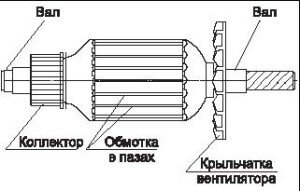
The rotor device does not require any explanation, since everything is shown in the photograph in Fig. 4 and a schematic representation of the electric motor rotor.
asynchronous collector motor single-phase alternating current
The electrical diagram of the collector motor in Fig. 5 is as follows:
In the circuit, we can notice that the collector motor can operate on both alternating and direct current - these are the laws of physics.
The two stator windings of the electric motor are connected in series. Two graphite brushes in contact - in electrical connection with the motor rotor collector.
The electrical circuit closes on the rotor windings, - accordingly, the rotor windings in the electrical circuit are connected in parallel through the brush-collector sliding contact.
diagnostics of stator windings of an electric motor
The photograph shows one of the methods for diagnosing the stator windings of an electric motor. In this way, the integrity or insulation breakdown of the stator windings is checked. That is, one probe of the device is connected to any of the removed ends of the stator windings, the other probe of the device is connected to the stator core.
In the event that the insulation of the stator winding is broken and the winding wiring shorts to the core, the device will indicate a zero resistance value in the short circuit mode. It follows from this that the stator winding is defective.
The device in the photograph indicates a one when diagnosing - this does not mean that this stator winding is suitable for operation.
It is also necessary to measure the resistance of the windings themselves. Diagnostics is carried out in the same way, - the probes of the device are connected to the removed ends of the wires of the stator windings. With the integrity of the windings, the display of the device will indicate the resistance value possessed by this or that winding. If one or another stator winding breaks, the device will show "one". If the stator winding wires are short-circuited with each other as a result of overheating of the electric motor or for other other reasons, the device will indicate the lowest zero resistance value or "short circuit mode".
How to check the resistance of the rotor winding with a device? - To do this, you need to connect two test leads of the device to two opposite sides of the collector, that is, you need to make the same connection that graphite brushes have in electrical connection with the collector. The diagnostic results are reduced to the same indications as when diagnosing the stator windings.
What is a collector in general? - The collector is a hollow cylinder consisting of small copper plates of a special alloy, isolated from each other and from the rotor shaft.
In the event that the damage to the collector plates is insignificant, the collector plates are cleaned with fine-grained emery paper. Again, this amount of work can be performed directly only by specialists who repair electric motors.
The electrical circuit in Fig. 7 consists of a battery and a light bulb, this circuit is comparable to that of a pocket flashlight. One end of the negative potential wire is connected to the stator core, the other end of the positive potential wire connects to one of the brought out ends of the stator windings. If the wires are connected the other way around, that is, "plus" to the stator core, "minus" to the withdrawn end of the stator winding, nothing changes from this.
In the presence of insulation breakdown, when the stator winding is closed with the core, the light in this electrical circuit will be on. Accordingly, if the light does not light up, then the stator winding is not closed with the stator core.
This method of diagnosing Fig. 7 is not complete. Accurate diagnostics is carried out only with an Ohmmeter device or a Multimeter device with a set resistance measurement range, for subsequent measurement of the resistance of the stator windings.
Before you want to repair a hair dryer at home, you need to familiarize yourself with its device at least in general terms. So, a modern model of technology can consist of the following elements:
- an electrical cord to connect to an outlet;
- switch or speed switch;
- fan;
- heating element (spiral);
- engine.
As you can see, the design of the device is not at all complicated, so if you want to repair the hair dryer yourself, there should be no difficulties with the repair. Next, we will consider all the main breakdowns that can occur, and under each malfunction, we will tell you how to fix it. From the tools you will need a multimeter, a screwdriver (or an asterisk) and, possibly, a soldering iron.
Due to its simple principle of operation, the following breakdowns of a household hair dryer most often occur:
- there is no power at all (the device does not turn on);
- the fan does not spin or the blades are not gaining momentum well;
- during operation, a burning smell is heard or something sparks in the engine area;
- the hairdryer does not blow hot air (only cold air).
First of all, if the hair dryer does not turn on, you need to check the power at the outlet and the integrity of the electrical cord. To do this, you can use an indicator screwdriver or a special tester - a multimeter.We talked about how to use a multimeter and how to use the indicator correctly in the corresponding articles.
If there is power in the outlet, but the hairdryer does not work, carefully examine the appearance of the cord for repair: it may have been broken somewhere, frayed or cut. The most problematic places of the cord are considered to be the place of entry into the device body, as well as the point of connection with the electrical plug. If, apparently, no obvious reasons for the breakdown could be found, proceed to disassembling the case. It is not at all difficult to disassemble the case of the hair dryer with your own hands, the main thing is to find all the fasteners and unscrew them (they can be hidden behind stickers, rubber plugs, etc.).
When you get to the internal structure (pictured above), first look at where the electrical cord connects to the rest of the circuit. Very often, the motor does not start due to the fact that the wire falls off at the bonding point. If in your case everything is exactly like that, the repair can be completed with simple soldering or twisting of conductors.
Is the cord working, but the hairdryer still doesn't work? We carry out repairs further and check the rest of the chain elements. If you have a diagram of your device model, use the tester to ring out the remaining elements: fuse, switch and mode switch. It is not uncommon for a household electrical appliance to overheat and turn off due to a blown fuse. It needs to be replaced with exactly the same one in terms of characteristics.
By the way, the opposite situation happens - after turning on and drying the hair, the hair dryer does not turn off. This is also the fault of the switch itself!
Another malfunction - the power on / off button does not work. We have already described how to repair a light switch. The repair in this case is similar - check the break contacts with a tester, clean them to a metallic color, and if you cannot fix the breakage yourself, replace the switch. In the same way, check the mode switch, if the hair dryer does not switch speeds or does not regulate the temperature (for example, it does not work at 2 speeds), try to repair the regulator or perform a simple replacement.
Another type of breakdown is problems with a fan that does not accelerate. If the hair dryer does not work because the fan is not spinning, disassemble the case and see how clean the blades are. Sometimes the fan won't pick up speed because the hair is wrapped around it. For repairs, you just need to perform cleaning - remove the blades from the shaft, remove all debris and reinstall the fan in its seat.

By the way, if the fan smells of burning when you turn on the fan, then most likely the hair dryer stinks due to strong pollution. Very often, a thorough cleaning can help you solve the problem yourself at home with a minimum set of tools for an electrician!
Another equally popular malfunction is the burnout of the spiral, which is the main heating element. If your fan does not heat up or heats the air weakly, get to the spiral, ring it with a tester and make a visual inspection. You can try to repair a damaged heating element, but most often after repair (for example, joining a nichrome thread) several months pass and the hair dryer breaks down again. It is better to replace the spiral with a new one so that further damage does not occur.
Well, the last, most unpleasant breakdown is when the hair dryer does not work due to the engine burned out. In this case, during repair, you can only make sure with the help of a tester that it is the engine that is faulty. In addition, a burning smell and sparks in the fan area can be considered signs of breakdown.You are unlikely to be able to repair the device yourself, so it is better to either replace the engine or take the device to a service center.

That's all that I wanted to tell you about what to do if the hair dryer does not work and how to repair it yourself if the fan, switch or engine breaks down. We hope that the provided instruction was useful and interesting for you. By the way, an industrial model (construction) can be repaired using the same instructions in the pictures. In fact, the construction hair dryer is similar in design, only it is more protected externally and has more powerful parts inside!
Related materials:
Any hair dryer has an impeller motor and a heater. The impeller sucks in air from one side of the hair dryer, after which it blows over the heater and comes out hot on the other side. Also, the hair dryer has a mode switch and elements to protect the heater from overheating.
1 - impeller; 2 - electric motor; 3 - heater; 4 - thermal protection; 5 - mode switch; 6 - power cable
In household hair dryers, the fan is assembled on a DC collector motor designed for a voltage of 12, 18, 24 or 36 volts (sometimes there are electric motors operating at an alternating voltage of 220 volts). A separate spiral is used to power the electric motor. The constant voltage is obtained from a diode bridge mounted on the terminals of the electric motor.
The hair dryer heater is a frame assembled from non-combustible and non-conductive plates, on which a nichrome spiral is wound. The spiral consists of several sections, depending on how many operating modes the hair dryer has.
This is how it looks:

The spiral is wound on a heat-resistant frame
The hot heater must be constantly cooled by the passing air stream. If the coil overheats, it may burn out or cause a fire. Therefore, the hair dryer is designed to automatically shut off when it overheats. A thermostat is used for this. This is a pair of normally closed contacts placed on a bimetallic plate. The thermostat is located on the heater closer to the outlet of the hair dryer and is constantly blown with hot air. If the air temperature exceeds the permissible, the bimetallic plate opens the contacts and the heating stops. After a few minutes, the thermostat cools down and closes the circuit again.
The thermostat is highlighted in a red circle
Sometimes a thermal fuse is also used as additional protection. It is disposable and burns out when a certain temperature is exceeded, after which it must be changed.
Thermal fuse, appearance
To better understand how the hair dryer works, you can watch these two videos (watch the first video from the 6th minute):
The scheme of most household hair dryers is close to the one above. Let's consider it in more detail. The heater consists of three coils: H1, H2 and H3. Through the H1 spiral, power is supplied to the engine, the H2, H3 spirals serve only for heating. In this case, the hair dryer has three operating modes. In the upper position SW1, the circuit is de-energized. In the> position, the hairdryer operates at minimum power: power is supplied through the VD5 diode, which cuts off one half-wave of the alternating voltage, only one heating coil H2 is turned on (not at full power), the motor rotates at low speeds. In the> position, the hairdryer works at medium power: the VD5 diode is short-circuited, both half-waves of the alternating voltage are supplied to the circuit, the H2 spiral operates at full power, the motor rotates at nominal speed. In the> position, the hairdryer works at the maximum possible power, since the H3 coil is connected. When the button> is pressed, the heating coils H2, H3 are switched off, and the motor continues to run. Diodes VD1-VD4 are a full-wave rectifier. Inductors L1, L2 and capacitors C2, C3 reduce the level of interference that inevitably occurs during the operation of a collector motor.F1, F2 is a thermal fuse and thermostat.
Attention! Unplug the hair dryer before disassembling!
Parts of the hair dryer body are attached to each other using screws (screws) and special latches. Screw heads often have a non-standard shape: an asterisk, a plus sign, a pitchfork. Therefore, you may need the appropriate bits for your screwdriver. The latches, in turn, are sometimes very difficult to disconnect and even experienced craftsmen sometimes just break them off. Sometimes the recesses for the fastening screws are covered with stickers, plastic overlays or plastic plugs. The plugs are removed using a sharp object such as a knife or needle. In this case, there is a high probability of wrinkling the case and plugs a little. True, the hair dryer from this will not work worse. Sometimes the body halves are glued together. In this case, you have to cut them with a knife or scalpel, and after repair they glue them (for example, with epoxy glue).
You can watch an example of disassembling a hair dryer in this video:
Consider the most common hair dryer malfunctions:
Possible malfunctions: the spiral is burnt out
As a rule, a break is visible to the naked eye, even without a multimeter. There are several ways to repair a coil:
- You can place the dangling ends of the coil in a thin brass or copper tube and squeeze it with pliers.
- The spiral rests on a frame made of heat-resistant, non-conductive plates. In such a plate, you should carefully make a round hole with a diameter of about 2-3 millimeters with a sharp object, insert a short bolt with a washer there, tuck the broken ends of the spiral under the washer and tighten.
- Throw one dangling end over the other.
- The dangling ends can simply be twisted together. It should be noted that the third and fourth methods are less reliable than the first two. The fact is that when connecting the dangling ends with a throw and twist, the repaired section of the spiral has increased resistance and therefore overheats and burns out soon enough in the same place.
- Disassemble the donor hair dryer (of course, if you have one) and take it from there.
- (not for everyone): you can wind the spiral yourself. Where to get nichrome? For example, order in China.
- you can buy a ready-made spiral. To find the one you want, enter> in your browser's search bar. The spirals come in different capacities and are sold in sachets of several.
You can watch examples of repairing the spiral in these videos:
Video: repairing the Viconte VC-372 hair dryer (the spiral burned out)
Video: where you can buy nichrome
Possible malfunctions: voltage is not supplied, that is, there is a problem with the power cable
First, carefully examine the cable from the mains plug to the case for obvious damage. If so, remove the damaged section and solder the cable ends. Perhaps this is all a malfunction and the hair dryer will work. An example of cable repair is in the above video: How to disassemble and repair a Scarlet hair dryer.
Possible malfunctions: the engine is defective or hair is wound on its shaft.
If hairs are wound around the motor shaft, to remove them, you will have to dismantle the impeller. You will also need to remove the impeller if you are going to lubricate or replace the motor shaft. How to do this can be seen in these two videos:
Video: remove the impeller from the hair dryer
Video: how to remove the fan from the hair dryer motor
Also, in some cases, you can grasp the base of the impeller with your fingers and pull it off.
Regarding checking the electric motor, the author believes that the best way - from a safety point of view - is to dismantle the motor and connect it to a suitable power supply with short circuit protection. If the motor does not rotate, you need to check the integrity of the windings with a multimeter. If the winding breaks, you will have to buy a new motor (although you can rewind the old one, but this, perhaps, makes sense only as entertainment).If the engine sparks a lot, you will also have to buy a new one. Rubbing with alcohol in this case, if it helps, then not for long. One of the options where you can purchase a new engine is: order in China (search>).
Hair dryers with ionization - when this mode is turned on, they emit a lot of negative ions, neutralizing the positive charge on the hair, which makes it smooth and does not dry out. To create negative ions, a special module is used, located in the handle of the hair dryer. The wire coming out of this module is located in the area of the heater. The air is ionized when it comes into contact with this conductor.
It is possible to diagnose the health of the ionization module without special devices by indirect signs. If you no longer feel the difference when the ionization module is turned on and off - and you are convinced that the module receives a normal supply voltage - therefore, the module is faulty. Next, you need to find a module for the required voltage and suitable size. Look, again, in China.
In everyday life, a large number of electrical appliances are used to make life easier for the layman. But any technique tends to fail over time. Repairing a hair dryer can be easily done with your own hands at home, without asking for help from a service center.
A hair dryer is a device that is used to dry and style hair. It consists of the following structural elements:
- Engine;
- TEN - heating element;
- Fan;
- Thermal protection;
- Power cable;
- Regulators (fan speed, temperature, etc.).
The principle of operation of the household hair dryer is based on a low-voltage DC collector motor. In order for the device to turn on, a special lowering coil is used in its design, which helps to drop the voltage to the required level. It is installed inside the heating element. With the help of a diode bridge, the voltage is rectified. The engine has a steel shaft on which a fan is mounted (in most cases, it is made of plastic, although there are now professional models with metal blades). The fan can have two, three or even four blades.

The heating element of an electric hair dryer is presented in the form of a spiral with a nichrome wire. It is wound on a non-combustible base, which increases the safety when using the device. When plugged in, the coil begins to heat up, and the fan installed behind it blows warm air out of the hair dryer case. To protect against overheating, a temperature controller (adjustable during operation) and a thermostat are used. In addition, any hair dryer has a "cold wind" or "cool" button - when you press it, the spiral stops heating up, only the engine and the fan remain to work, respectively, cold air blows from the nozzle.

It should be noted that not all equipment has a thermostat. It is designed to control the heating of a block with nichrome during long-term operation of the device. For example, it can be a stationary professional hairdryer (used in hairdressing salons). When the coil reaches its maximum allowable temperature, the thermostat cuts off the power. After cooling, the contacts are turned back on.

Typical malfunctions of the Bosch LCD hair dryer (Bosch), Valera, Skil, Vitek, Scarlett (Scarlet) and others:
- Smells burnt. The smell can come from the coil, which has gotten the hair as a result of careless handling, or from burning of the internal parts of the circuit;
- Hair dryer does not turn on. The reason may be a breakdown of the engine, a broken power cord, a lack of voltage in the network;
- Decreased work efficiency. The power of the device depends on the cleanliness of the filter installed on the back of the case. If it gets clogged, then the device will start to work with less efficiency;
- The fan rotates very slowly.Most likely, something just bothers him;
- Hair dryer Braun (Brown), Philips (Philips) or Rowenta (Roventa) does not heat up. There are several reasons why this happens: the cold air button is blocked, the spiral is broken, the circuit is damaged, the thermostat does not work.

Before starting repairs, you need to know how to disassemble a Parlux, Saturn, Moser or Jaguar hairdryer yourself. There is nothing complicated in this, you just need an instruction and a screwdriver:
- There are two bolts on the back of the body. They need to be unscrewed and carefully removed. In some cases, there are more of them, make sure that all fasteners are removed;
- In parallel, you can also remove the cover from the top panel - there is a fan under it. Most often it is simply pressed against the body, so it comes out without problems if you pry it with a screwdriver;
- Under the top panel of the case there is a mode switch and a cold air button. Several wires are installed on the panel. Which are connected to the pins of the circuit. For further disassembly, they will need to be removed;
- Now you can remove the coil from the hair dryer head. It is necessary to act carefully, otherwise it may break, remove only after making sure that all fasteners have been removed;
- Under the spiral, respectively, there is a motor. Most often there is no need to get it out, since almost all malfunctions will be noticeable immediately at the place where the motor is connected to the contacts of the heating element. An exception is the need to replace a part, then a major repair is made.
Consider how to make an independent repair of a hairdryer Babyliss, Rowenta Brush Activ, Bosh, Remington and others at home. First of all, you need to clean the fan and motor shaft from hair. A lot of them are collected there even after several months of intensive use. To do this, you need to remove the back top panel and cut the hair, then simply remove it with tweezers or fingers. In no case should you wipe the parts with a damp cloth - this will damage the contacts. This is done anyway, regardless of the problem.

If it smells burnt, then you need to repair the spiral and filter. They can be cleaned with a dry soft brush. Just wipe the heater teeth and clean the filter. Be careful not to break the contacts during the cleaning process.

If the hair dryer does not turn on, then you need to check the power cable right away. Most often, it breaks at the base, because during operation, the hair dryer rotates many times in different directions along its axis. If everything is fine with him, then look at the contacts on the spiral. They can be 2, 3 or 4. When the device falls or hits, they sometimes get unsoldered, which causes the motor power to be cut off.
When the breakdown is related to the fan, it is as easy as shelling pears to repair the device. The first step is to check if the blades are intact. Of course, the efficiency of their work does not change too much from their state, but if cracks or notches are noticed, then it is better to immediately change the propeller. Then inspect the shaft. Sometimes small parts or other debris fall into the nozzle of the hair dryer, blocking the shaft, and it starts to spin slowly.
Now let's discuss the reasons why the spiral of dry warm air does not heat up with a professional Coifin, Steinel or Lukey hairdryer. As we said, there can be several reasons. For example, the cold air button is stuck. The principle of its operation is as follows: when you press the button, the contacts inside the case open, as a result of which the heating coil stops working. If it is open all the time, then the spiral simply cannot start heating. If the problem is not in the button itself, but in the contact, then you need to solder it yourself.
The cause of the breakdown may lie in the broken coil, its repair is a little more difficult to carry out than cleaning.In some models, it is made of low-quality material that breaks easily from impact. If some notches are missing on the base or mother-in-law is visible, it is replaced.
Video: how to repair a spiral in a hair dryer
A hair dryer consists of a motor, a fan, heating elements, an electrical circuit that makes the elements work in concert. Depending on the number of modes, the manufacturer, the element base, appearance, and the composition of the switches are different. But nothing more complicated than a semiconductor thyristor will not be inside. Therefore, we will carry out home repair of hair dryers with our own hands.
The body is held in place by screws. The heads are often of a non-standard design. This is a plus sign, an asterisk, a pitchfork. Therefore, first of all, before fixing the hair dryer, let's take care of a tool that can cope with such a task. Fortunately, a set of bits costs 600 rubles today.
Sometimes the case flaps are additionally fastened together with special latches. This is a separate problem: experienced craftsmen often break plastic, desperate to cope with civilized methods. There are no subtleties, they come up with hidden screws hidden under stickers, plastic inserts, removable regulator caps. The fasteners are fictitious. There are no useful functions.
The hair dryer motor is powered by direct current 12, 24, 36 V. To rectify the mains voltage, a diode bridge is used, in cheap models - a single diode. The filtering of power harmonics is carried out by a capacitor connected in parallel to the motor windings or as part of a more complex filter. Inductors are rarely used in hair dryers due to their exorbitant mass. Therefore, knowledge of the principles of smoothing pulsations with RC-chains is enough to cope with the construction of a schematic diagram of a hair dryer being repaired. Sometimes a single coil (inductance) is used by the filter element.
The hair dryer switch simultaneously closes the circuit through which the spirals will be powered, starts the motor. Further schematic of the intervention is determined by the complexity:
- only the rotation speed or only the temperature is regulated;
- the ability to select heating and air flow rate separately.
In most models of hair dryers, in parallel, there is protection against turning on the heaters when the motor is inactive. Protects the spiral.
Optionally available thermostat in the form of a special resistance or other sensitive element. Let's describe the breakdowns encountered by the faithful helpers of the beautiful half of humanity.
If the device is devoid of signs of life, it is unstable, the inspection begins with the power circuit. The repair of Rowenta hair dryers is schematically described below.
Attention! The described types of work require skills in handling electrical appliances. The authors disclaim responsibility for damage to health, property, arising from attempts to follow the recommendations given for repairing hair dryers.
Inspection of the power cord begins with a socket. There is a part of the malfunction: there is no voltage - the hair dryer does not work. If there is voltage in the outlet, the inspection of the cord begins with the entry point into the case, walk towards the plug. Work is performed on a de-energized device. A visual search for fractures and irregular formations - burners, insulation damage, fractures is carried out.
Then the case of the hair dryer is disassembled. Inside you have a chance to see the options for electrical resistance:
- A pair of detachable contacts.
- Soldering.
- The wiring is sealed in plastic caps.
The last element of the list characterizes a non-separable connection, therefore, the case for testing is too complicated. Skillful hands, or rather, smart heads, Ukrainian brothers in mind are advised to use an ordinary needle to repair a hair dryer. Those who immediately grasp the train of thought will skip the next paragraph, start testing directly.
Do-it-yourself hair dryer repair begins with a continuity of the wiring. A Chinese tester, a light bulb, an indicator will do.A needle is attached to one terminal, which is then inserted into the power core in the area of the cap through the insulation to copper. The second terminal probes the legs of the plug. The call goes through for both cores. It is not worth doing more than 1 puncture per core when repairing a hair dryer (some will try to look for a breakage as well), since the nature of the operation involves the ingress of moisture from wet hair.
Even a child can ring the wire, having visually distinguishable docking points in front of his eyes. If damage is found, it is recommended to buy a new cord fitted with a non-separable plug. The likelihood of moisture ingress imposes restrictions on the choice of insulation of conductive parts used to repair a hair dryer.
Cases are common: the first glance reveals the place of damage to the cord entrance into the case. Slabs, carbon deposits, black insulation indicate the location of the fault.
At the junction with the body of the hair dryer, there is a vulnerable point of the wiring. The hostess takes the delicate device by the cord, shakes it from side to side, winds the cable around the handle. A vein with a crack sparks, the insulation heats up, burns out, the copper melts. This is the mechanism of damage to copper conductors.
When updating, it is useful to short-circuit the switch, check: the hair dryer will change the behavior radically in response to an uncomplicated step. There are three-position switches, each position in a short-circuited state is checked separately. Remember, sketch out the original wire layout before you start fixing the hair dryer.
Checking the speed, temperature switches uses a similar circuit.
Examine the defective element identified during the restoration of the hair dryer. The carbon deposits are cleaned off with a file, sandpaper, eraser. The contacts are wiped with alcohol. Defective components are replaced with equivalents. A radical method is to short-circuit the power button while searching for suitable components.
Relatively often, the air duct is clogged with a hair dryer. It is necessary to remove the filter, if any, and clean it thoroughly. Remove dust from crevices with a soft brush.
Lack of blade rotation or low rpm is often observed when the hair is coiled around the motor shaft. The propeller must be carefully removed from the shaft, in every possible way avoiding unnecessary efforts and distortions. After that, foreign objects are removed.
A hair dryer usually has several heating elements. Visually, they should all look uniform. Make sure of this when fixing the hair dryer by opening the case. The detected breaks are eliminated by twisting the ends, soldering and tinning. You can also get some thin copper tubes and squeeze the ends of the broken spiral inward.
We observe defects in heating elements during repairs visually. A close inspection will tell you how to fix your hair dryer. Replacing spirals with similar purchased or homemade products made of nichrome wire is effective.
The electric motor of the hair dryer can be powered by both direct current and alternating current. If the diode bridge is burned out, the windings are damaged, normal functioning is impaired. A terrible crackle and sparks when turned on indicate a malfunction of the motor.
The motor windings are desoldered when repairing the hair dryer from the electrical circuit. Find a pair for each wire that rings. The conclusions are connected in threes, none should hang in the air. Replacement of the winding when repairing a hair dryer is carried out only in a workshop. However, folk craftsmen shake not worse than machine tools. Those who wish will try.
If the windings are in good working order, the brushes are examined, the copper surface under them is cleaned, and the tightness is estimated.
The axis should rotate freely. When repairing a hair dryer, it will not hurt to lubricate the rubbing surfaces, manually break in problem areas.
The getinax backing sometimes cracks, tearing the track. Tin the damaged area, lightly cover with solder.
Broken capacitors swell slightly. The top face of the cylinder contains shallow slots, when the product breaks, the sidewall inflates, bending outward.Replace such a capacitor first if you find a characteristic defect.
Burnt-out resistors darken. Some remain operational, it is advisable to replace such a radio element.
Some hair dryers are self-regulating. The effect is achieved by using a resistive divider, one arm of which is an element that responds to temperature. Further actions are determined by the parameter control implementation scheme. We recommend:
- eliminate the sensor altogether by breaking the circuit, try the device's reaction;
- short-circuit the wires after that, turn on, see what happens.
There is a great chance of failure if the device is trained to respond only to a fixed resistance value. It remains to look for a schematic diagram on the Internet or draw it yourself.
Repairing professional hair dryers is more difficult. Structural elements are often complemented by smooth controls and additional options such as the Care button. The spirals are made of special alloys that create negative ions when heated, which have a beneficial effect on the hair. The technique remains the same:
- cord;
- switches and buttons;
- dust removal;
- spirals;
- motor;
- visual inspection of capacitors, resistors.
Before repairing it, it is advisable to get a schematic diagram.
Industrial models are not much different from household ones. But drying your hair is not recommended. Such products are distinguished by their increased resistance to dust, shock, vibration, humidity, and other climatic factors. Home restoration of industrial hair dryers will not end well.
| Video (click to play). |
Electric radio products used in household models are not suitable for use in harsh environments. Requirements apply to wires, power cord, motor and coils.

